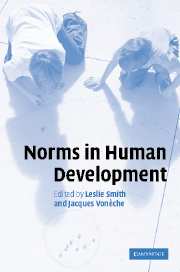Book contents
- Frontmatter
- Contents
- List of figures
- List of tables
- List of contributors
- Acknowledgments
- 1 Norms in human development: introduction
- Part I Norms and development in epistemology
- Part II Norms in moral and social development
- 6 Contextualizing moral judgment: challenges of interrelating the normative (ought judgments) and the descriptive (knowledge of facts), the cognitive and the affective
- 7 The development of obligations and responsibilities in cultural context
- 8 The multiplicity of social norms: the case for psychological constructivism and social epistemologies
- Part III Norms in cognitive development
- References
- Index
6 - Contextualizing moral judgment: challenges of interrelating the normative (ought judgments) and the descriptive (knowledge of facts), the cognitive and the affective
Published online by Cambridge University Press: 22 September 2009
- Frontmatter
- Contents
- List of figures
- List of tables
- List of contributors
- Acknowledgments
- 1 Norms in human development: introduction
- Part I Norms and development in epistemology
- Part II Norms in moral and social development
- 6 Contextualizing moral judgment: challenges of interrelating the normative (ought judgments) and the descriptive (knowledge of facts), the cognitive and the affective
- 7 The development of obligations and responsibilities in cultural context
- 8 The multiplicity of social norms: the case for psychological constructivism and social epistemologies
- Part III Norms in cognitive development
- References
- Index
Summary
Contextualization of moral judgments
Piaget did not only apply the biological metaphor of an equilibrated system to cognitive development but also used it very early (Piaget, 1918) to define morality as an equilibrium between the person and the society. He even reformulated the categorical imperative in these terms when he wrote: ‘Act in a way [so] that you can realize an absolute equilibrium of living organisms – the collective as well as the individual’ (after Kesselring, 1981, p. 196). This conceptualization already shows that from the very beginning he tried to contextualize morality, thus by necessity also referring to facts. Even later (Piaget, 1932) he retained this view by interpreting moral development as part of personality development. By doing so, he also linked moral judgments to the development of affects (Piaget, 1981). He contextualized the empirical analysis (methods) of moral judgments from the very beginning as well, by looking at children's everyday activities, which entail rule systems, like rules of games. He also constructed an impressive number of small scenarios that represent moral issues (like lying, distributive justice, immanent justice, responsibility, collective guilt etc.), which were intentionally rooted in the life context of children. So in Piaget's approach there was a close and intrinsic relationship between facts (knowledge of rules, understanding the facts of the scenarios, understanding and acceptance of the situation) and norms (what is right or wrong, what is worse etc.).
- Type
- Chapter
- Information
- Norms in Human Development , pp. 141 - 168Publisher: Cambridge University PressPrint publication year: 2006
- 6
- Cited by



